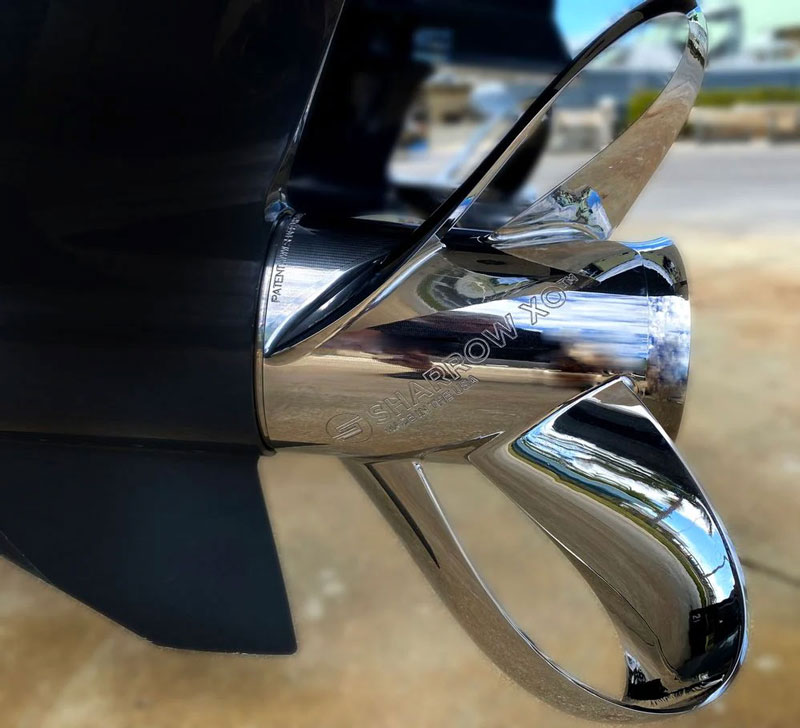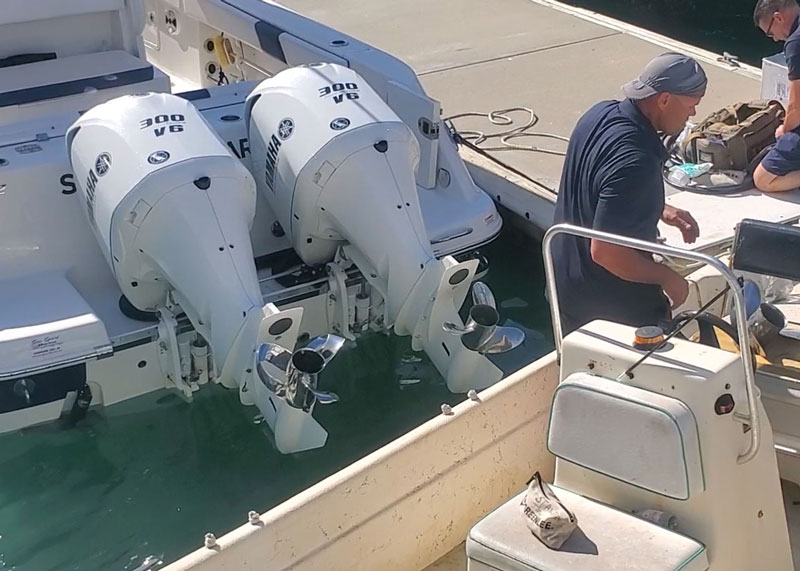Whether we spend our time Chesapeake Bay fishing or we head for the open Atlantic every time we leave the dock, we all want to make our fishing boats better. But the vast majority of the things we do amount to nibbling around the edges. We add a rodholder here and a cupholder there, replace a few cushions, and if we’re feeling really ambitious maybe mount a set of trim tabs where none sat before. But if you want to see a significant performance upgrade you’ll need to get radical and replace the powerplant or maybe just get a new boat. What if I told you that you could radically boost your midrange rpm cruising speed, reduce your fuel burn, and make your boat more pleasant to be on all at the same time?

We’ve been hearing about these new propellers made by Sharrow Marine, which have loops instead of blades. The idea is to attack cavitation, the efficiency-robbing effect that forms at the tips of all propeller blades and results in that monstrous stream of whitewater behind your boat. Where did all those bubbles come from? The prop is well below the waterline and if it were sucking in air from above would lose its bite, yet even at slow speeds when you look behind the transom you see torrents of aerated whitewash. The reason is pressure fluctuations which allow dissolved gas in the water to diffuse into bubbles (a process called “rectified diffusion,” for you tech geeks), as vortices whirl off the blade tips and cause atmospheric chaos.
The process is often compared to the way bubbles boil out of water when the temperature is high enough. Well, have you ever noticed that a boiling pot shakes, rattles, and makes plenty of noise? So does a cavitating prop. Net result? Your boat’s performance isn’t as strong as it could be, and as an added bonus, you get subjected to vibrations and noise. Yay.
The Sharrow attacks this problem by eliminating propeller blade tips altogether. Instead of traditional blades it generates its thrust with loops, which arc from the front of the prop’s outer hub to the back. The concept is so completely novel that the Sharrow MX was named one of TIME’s 2023 Best Innovations and has won a slew of awards including a National Marine Manufacturers Association (NMMA) Innovation Award.
Full disclosure: I was one of the judges on that NMMA panel, Sharrow is a FishTalk supporter (thanks folks!), and so far I’ve had just one on-the-water Sharrow experience. But it was an extended one, where we ran a 30’ center console with the stock manufacturer propellers and then took it back to the dock, swapped them out for Sharrow props, and ran the boat again.

The experience was illuminating. At 3000 rpm with stock props the boat was still in pre-plane mode, with its stern squatting and the sky-high bow pushing water at 14 mph. With the Sharrows spinning at 3000 rpm we ran at 24 mph, and efficiency leapt from 0.9 mpg to 1.4 mpg. As speeds increase the advantage shrinks a bit but remains substantial; at 4000 rpm the Sharrows maintained a four-mph edge, and at faster speeds hovered right around three mph.
This shakes out to an efficiency boost of around 60 percent at a slow 3500 rpm cruise and seven percent at a fast 4500 rpm cruise. Those are pretty compelling numbers, but they don’t tell the complete story. First, we need to note that different hulls and different power packages will see different results. Multiple engine rigs will obviously see the most dramatic improvements, since they’re spinning multiple propellers. Second, these propellers cost significantly more than regular stainless-steel props because each is custom-honed (to one to two thousandths of an inch tolerance) to fit the specific boat/power combination. Just how long it will take to recoup the cost via fuel savings will, of course, depend on just how much fuel you burn through the course of a season — though we’ve got to point out that at current fuel prices, if you have a 200-gallon tank that needs regular filling it certainly won’t take eons. And then, there’s the rest of the story…
Could these things actually help you catch more fish? As of today we can’t answer that question. What we can say for sure is that getting rid of all those whirling vortices and exploding bubbles dramatically reduces noise and vibration aboard the boat. So much, in fact, that standing aboard the deck of that 30-footer the smoother, quieter ride was for me, personally, more impactful than the efficiency boost. And as we all know, noise scares fish. Would swinging a set of Sharrows mean you could approach a school of breaking rock without freaking out the fish? Could you idle through the shallows without spooking the specks? We don’t know, but we hope to find out soon — stay tuned.